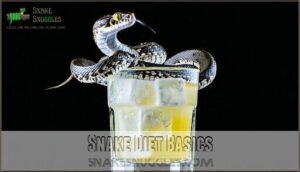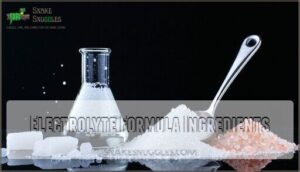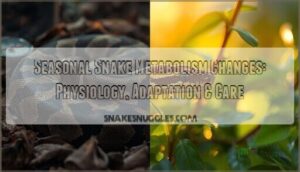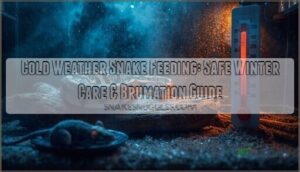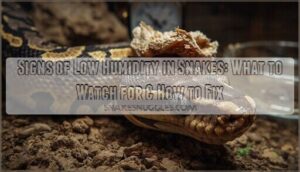This site is supported by our readers. We may earn a commission, at no cost to you, if you purchase through links.

It’s built around prolonged fasting, ketosis, and consuming an electrolyte drink called “Snake Juice.”
While some believe fasting boosts hormone regulation and cellular repair, this rigid diet can lead to nutrient deficiencies, dehydration, or fatigue if you’re not careful.
There’s little evidence that it specifically supports muscle or body growth like a balanced diet would.
If you’re considering it, talk to a healthcare professional first—it’s not one-size-fits-all, and extremes aren’t always the answer.
Curious about safer options? Read on.
Table Of Contents
- Key Takeaways
- Snake Diet Basics
- Weight Loss Principles
- Snake Juice Composition
- Diet Phases Explained
- Health Risks and Concerns
- Sustainable Weight Loss Alternatives
- Frequently Asked Questions (FAQs)
- What exactly is the Snake Diet?
- How do I start the Snake Diet?
- What is a snakes diet plan?
- What is Cole Robinson’s Snake Diet?
- How often should I feed my snake?
- Can snakes eat fruits or vegetables?
- What size prey is appropriate for my snake?
- Are there any foods toxic to snakes?
- Should I supplement my snakes diet with vitamins?
- How does the Snake Diet affect gut health?
- Conclusion
Key Takeaways
- You’ll fast for long periods and drink "Snake Juice" to maintain electrolytes, but the extreme nature of the diet poses risks like fatigue and nutrient deficiencies.
- Fasting triggers processes like ketosis and autophagy, which can aid fat burning and cellular repair, but muscle loss and reduced energy are concerns.
- Strict eating windows combined with prolonged fasting demand mental discipline and can negatively impact gut health, social life, and mental well-being.
- Sustainable weight loss and growth come from balanced diets, regular exercise, and professional guidance—not extreme restrictions.
Snake Diet Basics
You’ll follow a pattern similar to how snakes eat – consuming one substantial meal followed by extended fasting periods of 48-72 hours.
During these fasts, you’ll drink "Snake Juice", a specific electrolyte formula designed to maintain your body’s essential mineral balance while promoting rapid weight loss.
Extreme Intermittent Fasting
In the early days of your Snake Diet journey, you’ll encounter extreme intermittent fasting that goes far beyond conventional approaches.
The snake diet typically restricts your eating to just a 1-2 hour window daily, following an initial 48-hour fast.
- Fasting duration extends well beyond traditional 16:8 protocols, often reaching 72+ hours
- Muscle loss becomes a significant concern without proper refeeding strategies
- Exercise impact requires careful consideration as energy availability plummets
- Social isolation often accompanies extreme fasting due to meal-centered gatherings
Prolonged Fasting Benefits
While extreme fasting forms the backbone of the Snake Diet, it’s the extended periods without food that deliver surprising benefits to your body.
Extended fasting unlocks your body’s hidden potential, sparking autophagy, boosting growth hormone, and transforming stored fat into fuel for rapid weight loss.
Research shows prolonged fasting triggers autophagy activation, where your cells basically "clean house." You’ll experience improved insulin sensitivity, enhanced cellular repair, and stabilized blood glucose levels.
Your body’s growth hormone gets a natural boost during extended fasting periods, potentially offering protection against chronic diseases like cancer. The snake diet leverages these biological responses to create dramatic physical changes.
After 24 hours, the body begins enhanced ketosis initiation.
Importance of Electrolytes
While prolonged fasting pushes your body into fat-burning mode, your electrolyte balance becomes more critical than ever.
During the Snake Diet, you’ll need Snake Juice to prevent electrolyte imbalances that can derail your progress.
Without proper sodium, potassium, and magnesium levels, you might experience muscle cramps, weakness, and foggy thinking.
These minerals support proper nerve signals, muscle function, hydration balance, and cellular processes—keeping you functional while fasting.
Weight Loss Principles
You’ll experience dramatic weight loss on the Snake Diet through extreme calorie restriction and extended fasting periods that force your body to burn stored fat for energy.
Your body enters ketosis during these prolonged fasts, a metabolic state where fat becomes your primary fuel source instead of carbohydrates.
Calorie Restriction Methods
The Snake Diet relies on extreme calorie restriction—you’ll eat far fewer calories than you burn, creating a massive energy deficit.
- Your body enters survival mode, releasing growth hormone to preserve muscle
- Fasting duration typically ranges from 48-96 hours with minimal refeeding
- Nutrient timing becomes vital—all nutrients must fit in a 1-2 hour window
- Satiety signals often become disrupted during extended fasts
- Metabolic adaptation occurs as your body learns to function on less energy
Metabolic Changes Through Fasting
Transformation occurs in your body during a fasted state on the snake diet.
Your metabolism shifts dramatically after 24 hours when glycogen depletes and your body taps into fat stores.
You’ll experience increased fat oxidation, cellular autophagy, and improved insulin sensitivity.
Your metabolic rate initially decreases while fasting hormones trigger the release of fatty acids, which your liver converts to energy.
Growth hormone boost occurs, protecting muscle while your metabolism adapts to this new metabolic state.
The diet was founded by Cole Robinson, a self-proclaimed fasting coach who helps with metabolic state adaptation.
Role of Ketosis in Weight Loss
Your body enters a metabolic state called ketosis during the snake diet’s extended fasts.
When deprived of carbohydrates, your system switches to burning fat for fuel.
This ketosis mechanism triggers:
- Increased ketone production that can help suppress appetite
- Enhanced fat-burning as your primary energy source
- Metabolic adaptation that may preserve muscle tissue
- Reduced calorie intake through natural appetite control
This fat adaptation creates a significant calorie deficit, potentially accelerating weight loss through natural appetite control.
Snake Juice Composition
You’ll find Snake Juice contains a specific blend of water, Himalayan pink salt, potassium chloride, and Epsom salts designed to replace electrolytes during extended fasting periods.
This homemade electrolyte solution forms the cornerstone of the Snake Diet, providing essential minerals your body needs when you’re not consuming food, which is based on a specific blend of ingredients to support the body during fasting.
Electrolyte Formula Ingredients
Looking beyond plain water, the Snake Juice electrolyte formula combines specific ingredients to fuel your prolonged fasts.
You’ll need 2L of water mixed with 1 tsp of potassium chloride, ½ tsp of sodium chloride (Himalayan Pink Salt), 1 tsp of sodium bicarbonate, and an optional ½ tsp of magnesium sulfate.
This careful balance of electrolytes aims to support your body during the extreme fasting periods of the snake diet.
Maintaining proper levels requires potassium chloride supplements.
Benefits of Himalayan Pink Salt
Many proponents of the Snake Diet tout Himalayan pink salt as the cornerstone of the Snake Juice electrolyte formula due to its rich mineral content.
When following this extreme fasting protocol, you’ll supposedly benefit from:
- Natural electrolyte balance support during extended fasts
- Trace minerals that regular table salt doesn’t contain
- Hydration benefits that help combat fasting fatigue
- Lower processing than table salt, preserving mineral integrity
While these claims sound impressive, research on these benefits remains limited. You can even find chewable forms available for easier consumption, which may aid in maintaining proper electrolyte balance.
Potential Risks of Excess Sodium
While Himalayan pink salt provides minerals, the Snake Juice’s high sodium content comes with serious health concerns.
Your daily sodium intake limits exist for good reason—excess sodium raises blood pressure and increases heart risks over time.
This can damage kidney health, reduce bone density through calcium loss, and create dangerous electrolyte imbalance.
Despite claims that fasting prevents these issues, your body remains vulnerable to dehydration risks during extended fasts.
Diet Phases Explained
You’ll progress through three distinct phases on the Snake Diet, starting with a cleansing 48-hour fast and gradually moving to maintenance fasting based on your body’s hunger signals.
Each phase carefully structures your fasting windows and eating periods to maximize weight loss results while teaching your body to function efficiently on fewer meals, using maintenance fasting.
Initial 48-Hour Fast Benefits
During the initial 48-hour fast of the Snake Diet, your body undergoes significant transformations.
You’ll experience weight loss as your body depletes glucose stores and enters ketosis. This period initiates autophagy, enhancing insulin sensitivity while reducing inflammation.
According to Cole Robinson, maintaining electrolyte balance with Snake Juice is essential during this phase. You can find Snake Juice products online.
The mental fortitude required can be challenging, but many report improved clarity and an appetite reset once completed.
Phase 1 Fasting and Feeding Windows
In Phase 1 of the Snake Diet, you’ll start with an initial fasting period of 48 hours.
This kickstarts ketosis onset, helping your body adapt.
Afterward, you’ll eat within a strict 1–2 hour feeding duration, focusing on electrolyte intake to avoid dehydration.
Cole Robinson emphasizes this adaptation phase for rapid weight loss, preparing you for longer fasting later.
Phase 2 Weight Loss Strategies
After the 48-hour fast, Phase 2 ramps up the intensity.
Fasting durations stretch to 48–96 hours, with one meal in between, and meal frequency stays low, keeping your body in ketosis and pushing for weight loss success.
Electrolyte balance is critical here, so don’t skip the Snake Juice, and monitor your progress and adjust fasting to reach your goal weight without overdoing it.
Phase 3 Maintenance Techniques
To maintain your weight long-term, the third phase focuses on listening to hunger cues and staying flexible with your fasting schedule.
Aim for one meal every 24–48 hours while following these strategies:
- Refeeding strategies: Choose balanced nutrition for recovery after fasts.
- Calorie recommendations: Avoid over-restricting or overeating.
- Personalized adjustments: Adapt your approach for sustainable diet practices.
Health Risks and Concerns
Following the Snake Diet can expose you to serious risks like nutrient deficiencies and dehydration, which might leave your body struggling to keep up.
Its extreme approach could also lead to disordered eating patterns and long-term health concerns that aren’t worth the short-term results.
Nutrient Deficiencies and Malnutrition
The Snake Diet’s extreme nutrient deficiencies stem from limited eating windows, risking Vitamin Depletion, Mineral Imbalance, and Protein Insufficiency.
Without steady micronutrients, Bone Health and Immune Function can falter.
Malnutrition becomes likely as your body struggles to meet its needs. Poor shedding can also be a sign of malnutrition.
Prolonged deprivation may harm overall health, leaving you more vulnerable to nutritional deficiencies and long-term complications.
Potential for Disordered Eating
Extreme dieting, like the Snake Diet, can fuel disordered eating and unhealthy relationships with food.
Restrictive diets may lead to:
- Obsessive behaviors around meal timing and portions.
- Food stigma, labeling foods as “bad” or “cheating.”
- Damaged body image due to constant focus on weight.
These patterns create a psychological impact that’s tough to shake, leaving you stuck in a harmful cycle.
Impact on Mental Health and Wellbeing
Focusing on extreme fasting can lead to food obsession and disordered eating, increasing anxiety levels.
Extreme fasting fuels food obsession, anxiety, and disordered eating, disrupting mental health and fostering a harmful relationship with food.
The snake diet’s strict routine often causes social isolation, impacting emotional health and straining relationships.
Body image issues may worsen as mental health suffers from nutrient deficiencies, leading to cognitive effects like poor focus and mood swings, further highlighting how mental wellbeing can buckle under such extreme restrictions.
Physical Health Consequences
Prolonged fasting with the Snake Diet can push your body into dangerous territory.
Electrolyte imbalances lead to dizziness, dehydration, and serious organ stress.
Muscle loss and reduced bone density hit hard, especially with extreme dieting risks.
Add nutrient deficiencies, and you’re looking at long-term rebound weight gain.
Such health risks make sustainable goals harder, leaving your body struggling to keep up.
Sustainable Weight Loss Alternatives
If you’re aiming for lasting weight loss, extreme fasting isn’t your only option.
Choosing balanced meals, regular activity, and professional support can help you manage your weight in a safe and sustainable way.
Balanced Diet Approaches
After the extreme restrictions of the snake diet, a balanced diet offers a healthy reset.
Focus on Dietary Guidelines that encourage Food Variety and Nutrient Density. Think colorful plates—veggies, lean proteins, whole grains.
Portion Control keeps it realistic, making Sustainable Eating more achievable. A well-rounded diet nourishes your body naturally, unlike the growth hormone diet craze that overpromises.
Healthy Lifestyle Choices for Weight Loss
Adopting a healthy lifestyle for weight loss doesn’t have to feel impossible.
Mindful eating helps you tune into hunger cues, while portion control keeps meals balanced.
Pairing regular exercise with stress management can work wonders too.
Don’t underestimate sleep quality—rest supports healthy eating habits.
Instead of a snake diet, focus on small, sustainable lifestyle changes for long-term success.
Importance of Professional Guidance
When considering extreme approaches like the snake diet, qualified professionals are your best allies.
Medical oversight guarantees safety, minimizes health risks, and offers personalized plans adapted to your needs.
A registered dietitian or health professional advice can guide safe implementation, balancing benefit with ethical considerations.
Skipping medical supervision risks malnutrition or worse—always prioritize expert support before starting.
Long-Term Weight Management Strategies
Building sustainable habits is key to long-term weight management. Focus on realistic goals and lifestyle integration rather than quick fixes.
Practice mindful eating to foster a positive relationship with food. Healthy weight loss strategies should include variety, balance, and professional guidance.
The diet’s creator lacks nutritionist credentials, raising concerns. Relapse prevention is easier with psychological support, ensuring a sustainable weight loss journey.
Small, consistent changes create lasting success.
Frequently Asked Questions (FAQs)
What exactly is the Snake Diet?
The Snake Diet focuses on long fasting periods interrupted by brief eating windows, aiming for rapid weight loss.
It starts with a 48-hour fast using "Snake Juice," but lacks solid scientific backing and poses health risks.
How do I start the Snake Diet?
Ready to embrace a radical approach?
Start the Snake Diet with a 48-hour fast, sipping Snake Juice for electrolytes.
Then, follow strict fasting cycles, eating in short windows.
Consult a doctor first—health matters!
What is a snakes diet plan?
A Snake’s diet plan involves extreme fasting periods up to 96 hours, broken by single low-carb meals.
You’d drink "Snake Juice" — a salty electrolyte drink — to sustain energy, avoiding overeating during brief eating windows.
What is Cole Robinson’s Snake Diet?
Cole Robinson’s Snake Diet is an extreme fasting regimen focused on prolonged fasts and short eating windows.
It starts with a 48-hour fast, uses “Snake Juice” for electrolytes, and emphasizes rapid weight loss through intense restriction.
How often should I feed my snake?
Think of meals as rare treats.
Feed your snake every 5–14 days, depending on species, age, and size.
Smaller snakes eat more often, while adults need less frequent meals.
Always match prey size appropriately.
Can snakes eat fruits or vegetables?
Snakes don’t eat fruits or vegetables as their diet is strictly carnivorous.
They rely on whole prey like mice, birds, or insects, which provide the nutrients they need for energy, growth, and survival.
What size prey is appropriate for my snake?
Choose prey that’s about as wide as your snake’s thickest point.
Too big can harm or stress the snake; too small won’t satisfy its needs.
Feed appropriately sized meals for safe, healthy growth.
Are there any foods toxic to snakes?
Imagine your snake nibbling an avocado—don’t let it happen!
Foods like avocado, chocolate, alcohol, and caffeine are toxic to snakes.
Stick to prey they’d naturally eat, avoiding human foods for their safety.
Should I supplement my snakes diet with vitamins?
You generally don’t need to supplement your snake’s diet with vitamins if it’s eating a balanced, species-appropriate diet.
Over-supplementing can harm their health, so always consult a reptile vet before adding anything extra to ensure their diet remains species-appropriate.
How does the Snake Diet affect gut health?
Fasting-focused diets, like the Snake Diet, disrupt digestive rhythms, potentially unsettling gut health.
Prolonged fasting may reduce beneficial gut bacteria, risking imbalances.
It’s essential to assess long-term effects and prioritize balanced, fiber-rich meals post-fast.
Conclusion
Considering the Snake Diet for growth? It promotes fasting, ketosis, and electrolyte balance, but it’s not without risks.
While proponents claim it boosts metabolism and fat burning, its extreme nature may lead to nutrient deficiencies, fatigue, or dehydration.
Growth thrives on balance, not extremes. Instead, focus on sustainable options like a well-rounded diet and regular exercise.
Remember, health isn’t a one-size-fits-all journey. Consult a professional to confirm any plan suits your body’s individual needs, focusing on balance, sustainable options, and a well-rounded diet.
- https://www.dietaryguidelines.gov/sites/default/files/2021-03/Dietary_Guidelines_for_Americans-2020-2025.pdf
- https://www.ncbi.nlm.nih.gov/pubmed/14769489
- https://www.today.com/health/diet-fitness/nordic-diet-weight-loss-health-benefits-rcna21572
- https://pubmed.ncbi.nlm.nih.gov/29419624/
- https://www.healthline.com/nutrition/snake-diet

